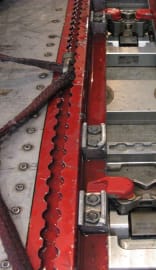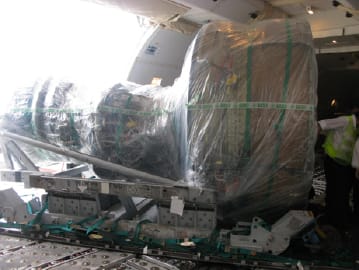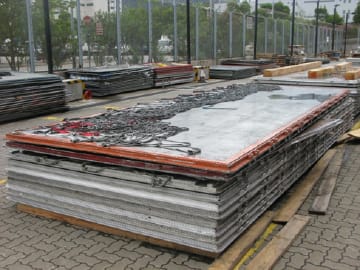Cargo Terminals, CARE, Ground Handlers, Special Cargo ULD, Storage
Managing 16 and 20 ft pallets
Virtually any airline operating freighter aircraft will at some time or other use 16 and 20 feet pallets. Indeed these pieces of equipment are essential components of modern cargo operations, playing the role of moving a huge variety of large and/or heavy and/or unusually shaped/oversized cargo. While pure passenger airlines will have no involvement with this equipment, any cargo operator, many ground handlers and most cargo terminals will find themselves using and even relying on these particular types of ULD for their operations. While similar in some respects to any other type of ULD the size and load capacity of these two pallet sizes does give rise to a certain degree of special operational and handling procedures.
First of all, we must point out that any guidance contained in this article is of purely informational value. The actual operation of 16 and 20 feet pallets must always be carried out in strict accordance with the aircraft Weight and Balance manual and the pallet manufacturers CMM. However, there are certain universal operating practices that should be applied at all times.
Firstly, it should never be assumed that just because these size pallets look big and strong, they can be treated without any regard to the limitations of their strength. Yes it may indeed look possible to pick up a loaded 20 feet pallet with a forklift while carrying maybe 10 tons of cargo, but then don’t be surprised if the pallet bends and even snaps into two pieces. As like every other piece of ULD, 16 and 20 ft. pallets are designed to be supported on properly designed and constructed ground handling/storage equipment and only lifted with a forklift when empty…. big does not necessarily equate to strong enough to mistreat !!
Secondly, just because they look big and strong does not mean 16 and 24 pallets do not get damaged. Like any other piece of ULD equipment, they can and will be damaged. Unlike a standard PMC or PAG where damage to the base sheet is generally visible this will not necessarily be the case with a 16/20 feet pallet. Here is where very big problems can arise, as the loading onto an aircraft of a damaged 16/20ft pallet can cause tremendous amount of damage to the aircraft floor and cargo loading system and lead to very substantial flight disruptions. 16/20ft. pallet should be inspected before use by lifting (empty) with a forklift to a sufficient height that the underside can be visually inspected (do not stand underneath the pallet during this process – view from an angle please!)
Thirdly 16/20 ft. pallets employ a different aircraft locking system than PMC and PAG pallets. The small blocks located on both long sides of these pallets are an essential component of the locking system and if missing or severely damaged can result in the pallet not being able to fly. Just because they are small does not mean these items can be taken for granted.
Fourthly, while they look and feel unbreakable, the placing of cargo having a concentrated load footprint on top of the pallet can quickly damage the structure of the pallet. Any heavy cargo will require the use of spreader boards (shoring) if the pallets are not to be damaged by two concentrated a load. IATA standard specification states that any 16/20 feet pallet be capable of withstanding a load of 3900 Kg/sq m (800 lbs per square ft.). This limitation should never be overlooked as it will inevitably result in damage to the structure of the pallet and potentially damage to the aircraft cargo loading system.
When it comes to loading and securing the cargo onto a 16/20 feet pallet there are also some important considerations:
Very often the cargo will be of a heavy nature requiring the use of cargo straps rather than cargo nets, in which case the quantity and placing of these straps shall be done in accordance with the airlines loading manual. Where special cargo such as vehicles are concerned a specialist operations engineer shall be consulted.
Where the cargo is of such a nature that it can be loaded underneath a standard cargo net (for example when a pallet has been repositioned and is loaded with general cargo), then only a correct size net, compatible with the pallet, shall be used and never any kind of combined PMC or PAG nets.
Although it falls somewhere outside the subject of 16/20 ft. pallets, it is worthwhile to mention the use of pallet couplers which are sometimes employed to join two PMC pallets to create what appears to be a 20 ft. pallet. However, such a creation does not in any respect equal a 20 feet pallet, as the means of restraint employed for a 20 ft. pallet is completely different from that employed to restrain PMC pallets and the two are incompatible. Where two PMC pallets are coupled together to create a 20 ft. long device, this should only be considered as a floating pallet, where the actual load will be restrained directly to the aircraft floor and where the aircraft cargo loading system locks have no function.
To conclude, 16/20 feet pallets are essential components of modern air cargo operations and contribute to operational flexibility and economic viability of freight operations. However, these items are subject to physical and operational limitations that require operators understanding. Otherwise, the possibility of unintended and potentially serious consequences is high.

Close up of 20 ft. pallet locking system. Note how the small blocks along the sides of the pallet play an important part, preventing forward/aft movement of the pallet in flight. They can take tremendous loads.

Engine being loaded on a 20 ft pallet, a common occurrence but one that requires proper care and attention to the ULD if problems are to be avoided.

20 ft. pallets at a cargo terminal, it’s OK to lift empty ones by forklift but never support a loaded 20 ft. pallet any other way than on proper roller systems.


